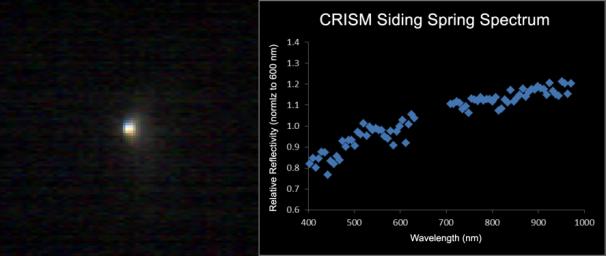
|
Mars-Orbiting Spectrometer Shows Dusty Comet’s Spectrum
- Click the image above for a larger view
- Full-Res JPEG (1878 x 794) (94.8 kB)
- Full-Res TIFF (1878 x 794) (4.5 MB)
Caption:
The Compact Reconnaissance Imaging Spectrometer for Mars (CRISM) aboard NASA's Mars Reconnaissance Orbiter obtained this spectrum for comet C/2013 A1 Siding Spring during the comet's close approach to Mars.
The left panel shows a CRISM image of comet Siding Spring taken on October 19, 2014, around the time of closest approach of the comet to Mars. The scale is 2.5 miles (4 kilometers) per pixel and only a small inner coma is visible.
The right panel shows a weighted average spectrum of the entire comet as seen in all the CRISM images. The spectrum appears to show a dusty comet with no strong emission lines. There is a red slope to the average reflectivity -- meaning the comet is more reflective at longer (redder) wavelengths. Subtle colors in the image in the left panel are most likely related to changes in particle size and/or composition.
The image at left was previously released as PIA15291 .
Background Info:
CRISM is one of six instruments on NASA's Mars Reconnaissance Orbiter. The Johns Hopkins University Applied Physics Laboratory in Laurel, Maryland, provided and operates CRISM. NASA's Jet Propulsion Laboratory, a division of the California Institute of Technology, Pasadena, manages the Mars Reconnaissance Orbiter Project for NASA's Science Mission Directorate, Washington. Lockheed Martin Space Systems, Denver, built the orbiter and supports its operations. For more information about NASA Mars missions, visit http://mars.nasa.gov .
Cataloging Keywords:
| Name | Value | Additional Values |
|---|---|---|
| Target | Mars | C/2013 A1 (Siding Spring) |
| System | ||
| Target Type | Planet | Comet |
| Mission | Mars Reconnaissance Orbiter (MRO) | |
| Instrument Host | Mars Reconnaissance Orbiter | |
| Host Type | Orbiter | |
| Instrument | Compact Reconnaissance Imaging Spectrometer for Mars (CRISM) | |
| Detector | ||
| Extra Keywords | Color, Dust | |
| Acquisition Date | ||
| Release Date | 2014-11-07 | |
| Date in Caption | 2014-10-19 | |
| Image Credit | NASA/JPL-Caltech/JHUAPL | |
| Source | photojournal.jpl.nasa.gov/catalog/PIA18865 | |
| Identifier | PIA18865 | |
